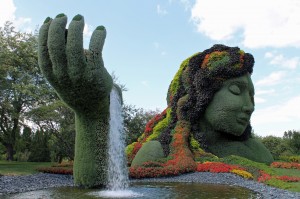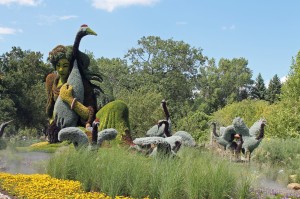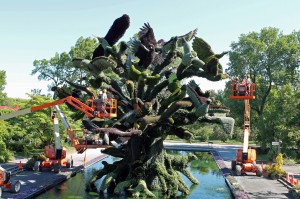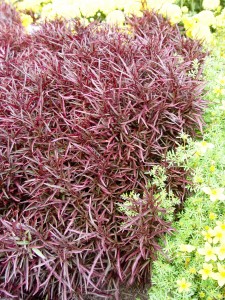Plants As You’ve Never Seen Them
August 20th, 2013
Plants are objects of great beauty when they’re artfully arranged in a garden and skillfully maintained.
Then there are Mosaicultures.
If you’re not familiar with that term or have never seen a Mosaiculture, picture metal frames stuffed with tightly packed potting mix and planted with assorted colorful plants to create a living piece of art.
A Mosaiculture is somewhat like a topiary, but instead of being an evergreen trimmed into a shape, it’s a creation of living plants limited only by what the plant artist can imagine.
Some Mosaicultures are so big and impressive that they’re beyond anything you’ve likely seen a plant do.
The technique isn’t very well known in the United States, but there’s an international competition in Mosaiculture that’s held every 3 years.
This summer, the competition is taking place in the Montreal Botanical Garden in Canada, where 48 different Mosaicultures are on display until Sept. 29.
I’m just back from seeing it, and I’d rate it as the most amazing horticultural event I’ve ever seen.
The most mind-blowing to me is the 50-foot-tall “Mother Earth,” created by Canada’s team.
Set next to a pond, Mother Earth’s head and face are made out of trimmed green santolina with a variety of colorful trailing plants streaming down as the hair.
Jutting out of the pond is Mother’s huge forearm and hand – also made out of green santolina – with a waterfall pouring down from her open palm. Mosaiculture horses and deer romp in the lawn and wildflower meadow in front.
That’s just one of the 48 plant sculptures scattered throughout the 185-acre Montreal Botanical Garden, which also happens to be a terrific public garden even without Mosaicultures. (The Chinese Garden is particularly big and superb.)
Each Mosaiculture is supposed to tell a story and/or represent a part of the culture of the team creating it.
That makes it a blend of sculpture, horticulture, engineering, culture and, more than anything else, way-outside-the-box artful imagination.
Shanghai’s entry, for instance, is a sprawling scene called “A True Story.”
It features a Chinese girl in a red, green and gold plant-created dress, holding a large crane while other cranes land in the water nearby. It’s called “A True Story” because it represents a well known Chinese event from the 1980s when a girl drowned while trying to save a crane.
Another poignant one is Canada’s “The Man Who Planted Trees,” which shows a 40-foot-tall caped shepherd kneeling over to plant a sapling in his rocky pastureland. Floral sheep graze nearby, and the shepherd’s trusty dog – made out of shaggy brown carex plants – looks out at the photo-snapping audience.
The most intricate is another Canadian creation called “The Bird Tree.”
This one is a 50-foot-tall tree “growing” out of reflecting pool. Fifty-six different species of Canadian birds are perched on the branches.
The thing weighs 100 tons, has 150 individual frame parts and is planted with 300,000 plants.
To keep it looking good, garden staffers use aerial ladder trucks (“cherry pickers”) to constantly trim, water and primp it. They also climb up into it using ropes.
If you’ve ever tried to keep a simple hanging basket looking good all summer, you’ll appreciate the incredible skill that goes into caring for this giant planter.
Like all of the Mosaicultures, elaborate planning and calculating went into building The Bird Tree in the first place.
Work started with a sketch. Then came a model mock-up, followed by engineering calculations to make sure the whole thing wouldn’t crumble or blow over in a windstorm.
The frame itself was built a year in advance. Welders, designers and craftsmen spent 3 months making the steel core for the trunk and the aluminum branches and bird frames.
It was assembled on site in March. Then the frame was covered with a tight mesh, into which the potting mix was stuffed.
A drip-irrigation system was installed at the same time.
Planting took place in April. To me, that’s the most difficult part because you not only have to pick plants that are the right colors and forms to make it look like what you’re shooting for, but these plants have to live and thrive 50 feet off the ground in exposed soil.
Even trickier is the fact that some of the plants will face sunnier spots than others, and some will get shaded in sections that are underneath higher parts of the structure (in this case, the higher branches shade the lower ones).
Through experience, veteran Mosaiculture artists have zeroed in the particular plants that do best in this kind of challenge.
The favorite: alternanthera.
This is a fairly large family of tender plants that comes in a variety of colors and doesn’t resent constant trimming. Alternanthera also happen to be pretty tough in a variety of conditions and light settings.
Throughout Montreal’s competition, you’ll find 33 different kinds and cultivars of alternantheras – by far the most of any species.
Also popular are echeveria (5 kinds), creeping sedum (6 kinds), iresine (5 kinds), and both green and gray santolina. Carex are good choices when the sculpture calls for something shaggy, and creeping thymes are ideal for low mats.
To get the colors right, Mosaiculture artists rely almost entirely on plants with colorful foliage, such as the nearly black ‘Chocolate Chip’ bugleweed, golden oregano and silvery-gray dichondra ‘Silver Falls.’
Foliage color stays consistent from beginning to end as opposed to flowering plants whose blooms might come and go in a matter of weeks.
When blooming plants are used, it’s almost strictly annual flowers, which generally bloom all season and then die at season’s end. No matter there because Mosaicultures come down then anyway.
Some of the annuals used to give color to Montreal’s Mosaicultures: ageratum for blue, impatiens for red, dwarf bidens for yellow, zinnias for orange, gloriosa daisies for gold and scaevola for purple.
In all, 20 different countries are participating in the 2013 competition. The 48 Mosaicultures are planted with nearly 3 million individual plants.
The United States has two entries. One is a scene of California farmers bringing in the harvest (by California Polytechnic State University), and the other is a scene of endangered frogs romping by a pond (by the Atlanta Botanical Garden).
The Atlanta Botanical Garden also has a display of 19 Mosaicultures taking place this summer through October. It’s the first time Montreal’s Mosaicultures have been displayed in the United States. More information is on ABG’s web site.
If you want to see more of Montreal Mosaicultures, I’ve posted a Photo Gallery from the 2013 show at https://georgeweigel.net/photo-galleries.
And if you’re thinking of going up to Montreal to see the show first-hand, check out the Mosaicultures Internationales web site.











